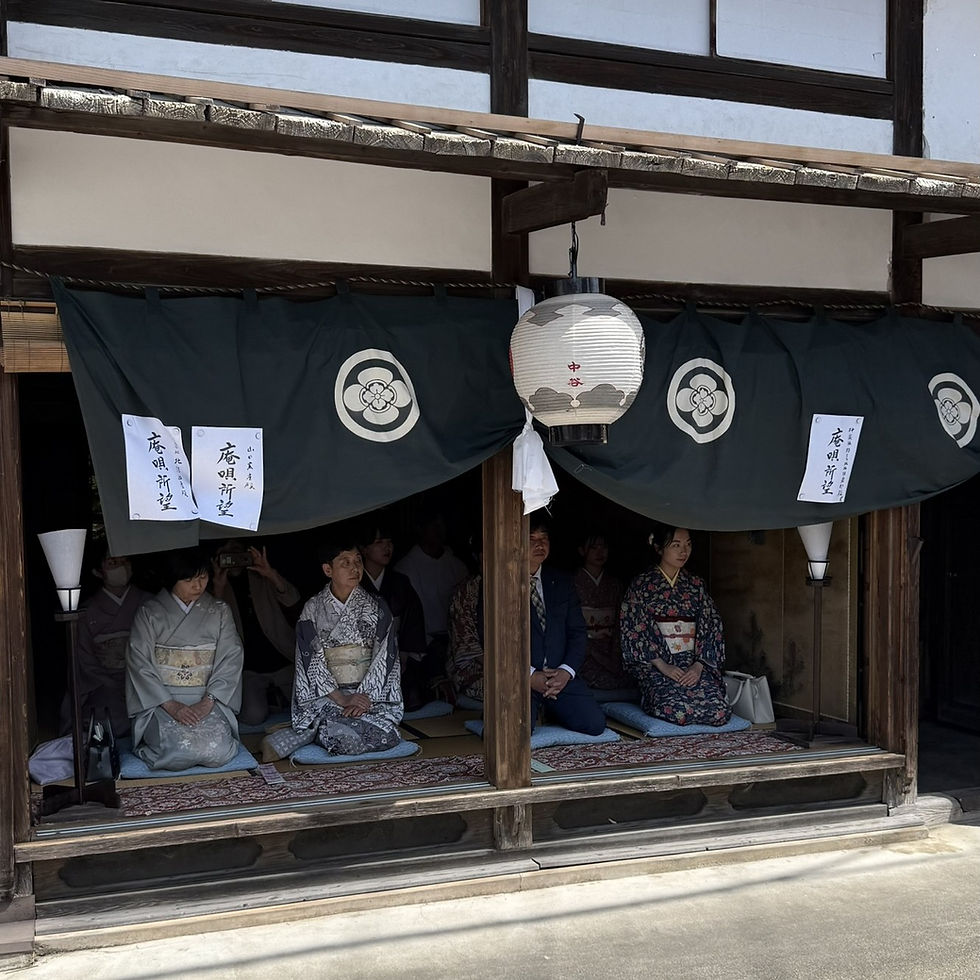Feel the Legacy of Both Kyoto and Tokyo — Experiencing the Johana Hikiyama Festival 2025 in Toyama
- Shinya Yamada
- May 7
- 4 min read
Updated: May 10

Johana Hikiyama Festival in Toyama: A 300-Year-Old Festival Registered as UNESCO Intangible Cultural Heritage
For the second year in a row, I visited the Johana Hikiyama Festival held in Jōhana, Nanto City, Toyama Prefecture. This traditional festival, with a proud 300-year history, is registered as a UNESCO Intangible Cultural Heritage. The exquisite detailing and lacquered finish of the festival floats (hikiyama) are simply breathtaking. On May 5, six elaborately adorned floats carrying sacred statues paraded through the streets, captivating the onlookers.

Jōhana: “The Little Kyoto of Ecchu” and the Temple Town of Zentokuji
Jōhana is often referred to as the “Little Kyoto of Ecchu.” It developed as a temple town for Jōhana Betsuin Zentokuji, founded about 530 years ago by Rennyo Shonin, the 8th head of the Honganji sect. Today, it remains an important temple of the Higashi Honganji (Shinshu Otani-ha) branch of Jodo Shinshu Buddhism.

During the Edo period (1603-1867), under the protection of the powerful Maeda clan of the Kaga Domain, Jōhana prospered through silk weaving. Located just 20 minutes by car from the World Heritage site of Gokayama—known for its silk production—Jōhana became a hub for silk textiles.

Where Kyoto and Edo Cultures Converge
Originally, most silk woven in Jōhana was transported to Kyoto’s Nishijin district for refining and dyeing. Later, it also came to be sold in Edo (now Tokyo). This led to a fusion of cultural influences from both Kyoto and Edo, giving birth to the unique features of the Jōhana Hikiyama Festival.

From intricately carved and lacquered floats inspired by Kyoto’s Gion Festival and the Ichiriki Teahouse, to precisely crafted “Iori-yatai” (tea-house style floats) modeled after Edo’s Yoshiwara teahouses, the festival embodies a deep blend of both traditions. Even the music—called Iori-uta—originates from Edo-hauta, a shamisen-based popular music form that flourished in the 1840s.

The Romance of Edo-hauta: Lost in Tokyo, Preserved in Jōhana
Edo-hauta, once a beloved form of shamisen balladry in the 1840s, reached its peak in the Taisho period, particularly in the pleasure quarters. However, it declined during the Showa era, overtaken by the rise of newer genres. Unlike other musical forms, Edo-hauta lacked a hereditary system (iemoto), which made transmission across generations difficult.

While it faded in Tokyo, it remained vibrant in Jōhana, hundreds of kilometers away—a living cultural bridge to Edo’s past. The survival of Edo-hauta here is a story of historical romance and cultural resilience.

Toyama Prefecture: A Living Repository of Hikiyama Traditions
According to the “Toyama Cultural Heritage Promotion Committee,” hikiyama festivals are held in 21 regions across Toyama Prefecture. Among them, Jōhana, Takaoka, and Uozu have been recognized as UNESCO Intangible Cultural Heritage events.

Takaoka’s Mikurumayama Festival is said to be the origin of Toyama’s hikiyama traditions. It is believed that the mikurumayama (imperial-style carriage floats) originated from a ceremonial cart gifted to Maeda Toshiie by Toyotomi Hideyoshi during an imperial procession in 1588. This float was later passed to the townspeople when the second Kaga lord, Maeda Toshinaga, founded Takaoka Castle in 1609. Since then, the ten neighborhoods of Yamacho in Takaoka have preserved and passed on this heritage.

Jōhana’s Unchanging Procession Since the Edo Period
While many regions have modernized their festivals, Jōhana remains the only place in Toyama to preserve the old-style “kami-mukae” (welcoming procession of the gods) format from the Edo period.
Known for its traditional atmosphere and elegant visuals, Jōhana is home to dazzling floats, the graceful melodies of Iori-uta, and the majestic ambiance of a true cultural celebration. As night falls, the floats are illuminated by lanterns, transforming the scenery into a mystical dreamscape that contrasts beautifully with the daylight pageantry.

Experience Iori-uta at “Kagurazaka Street Stage O-edo Tour 2025” in Tokyo
For those who missed the Jōhana Hikiyama Festival, you can still experience its charm during the “Kagurazaka Street Stage O-edo Tour 2025,” held on May 17–18 in Tokyo’s Kagurazaka.
Musicians and performers from Jōhana—including shamisen, flute, and taiko players—will bring the authentic sound and spirit of the hikiyama festival to the streets of Kagurazaka. Accompanied by traditional melodies and elegant vocals, they will parade through the historic alleyways, transporting you to the world of Edo.

Performance Schedule:
May 18 (Sat): Starts at 17:30 from Bishamonten Zenkokuji
May 19 (Sun): Starts at 12:00 and 14:00 from Bishamonten Zenkokuji
It’s a rare and moving “homecoming” for Iori-uta—returning to Edo (Tokyo), where its cultural roots began, after centuries of preservation in Toyama.
Next Time: Discovering the Allure of Takaoka, Toyama
In the next blog post, I’ll share my impressions from visiting nearby Takaoka City—home to national treasures like Shokōji Temple and the scenic Amaharashi Coast. Takaoka is a hidden gem of Hokuriku that rivals even Kanazawa in charm and cultural richness. Stay tuned!

Book Each Experience
How to Access Kagurazaka
The Kagurazaka area is conveniently located within 30 minutes from any major station in Tokyo. This is because Kagurazaka is situated in the heart of Tokyo, at the center of the Yamanote Line. Please come and visit this convenient and charming Kagurazaka.








Comments